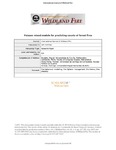Mostrar o rexistro simple do ítem
Poisson mixed models for predicting number of fires
| dc.contributor.author | Boubeta, Miguel | |
| dc.contributor.author | Lombardía, María José | |
| dc.contributor.author | Marey Pérez, Manuel Francisco | |
| dc.contributor.author | Morales, Domingo | |
| dc.date.accessioned | 2023-12-11T08:18:51Z | |
| dc.date.available | 2023-12-11T08:18:51Z | |
| dc.date.issued | 2019-03 | |
| dc.identifier.citation | M. Boubeta, M. J. Lombardía, M. Marey-Pérez, y D. Morales, «Poisson mixed models for predicting number of fires», Int. J. Wildland Fire, vol. 28, n.º 3, pp. 237-253, mar. 2019, doi:10.1071/WF17037 | es_ES |
| dc.identifier.issn | 1448-5516 | |
| dc.identifier.uri | http://hdl.handle.net/2183/34436 | |
| dc.description | © 2019. This manuscript version is made available under the CC-BY 4.0 license https://creativecommons.org/ licenses/by/4.0/. This version of the article: M. Boubeta, M. J. Lombardía, M. Marey-Pérez, y D. Morales, «Poisson mixed models for predicting number of fires», Int. J. Wildland Fire, vol. 28, n.º 3, pp. 237-253, mar. 2019, doi: 10.1071/WF17037, has been accepted for publication in International Journal of Wildland Fire. The Version of Record is available online at https://doi.org/10.1071/WF17037 | es_ES |
| dc.description.abstract | [Abstract]: Wildfires are considered one of the main causes of forest destruction. In recent years, the number of forest fires and burned area in Mediterranean regions have increased. This problem particularly affects Galicia (north-west of Spain). Conventional modelling of the number of forest fires in small areas may have a high error. For this reason, four area-level Poisson mixed models with time effects are proposed. The first two models contain independent time effects, whereas the random effects of the other models are distributed according to an autoregressive process AR(1). A parametric bootstrap algorithm is given to measure the accuracy of the plug-in predictor of fire number under the temporal models. A significant prediction improvement is observed when using Poisson regression models with random time effects. Analysis of historical data finds significant meteorological and socioeconomic variables explaining the number of forest fires by area and reveals the presence of a temporal correlation structure captured by the area-level Poisson mixed model with AR(1) time effects. | es_ES |
| dc.language.iso | eng | es_ES |
| dc.publisher | CSIRO | es_ES |
| dc.relation.uri | https://doi.org/10.1071/WF17037 | es_ES |
| dc.rights | Atribución 3.0 España | es_ES |
| dc.rights.uri | http://creativecommons.org/licenses/by/3.0/es/ | * |
| dc.subject | Empirical best predictor | es_ES |
| dc.subject | Forest fires | es_ES |
| dc.subject | Mean squared error | es_ES |
| dc.subject | Method of moments | es_ES |
| dc.subject | Plug-in predictor | es_ES |
| dc.subject | Time dependency | es_ES |
| dc.title | Poisson mixed models for predicting number of fires | es_ES |
| dc.type | info:eu-repo/semantics/article | es_ES |
| dc.rights.access | info:eu-repo/semantics/openAccess | es_ES |
| UDC.journalTitle | International Journal of Wildland Fire | es_ES |
| UDC.volume | 28 | es_ES |
| UDC.issue | 3 | es_ES |
| UDC.startPage | 237 | es_ES |
| UDC.endPage | 253 | es_ES |
Ficheiros no ítem
Este ítem aparece na(s) seguinte(s) colección(s)
-
GI-MODES - Artigos [142]






